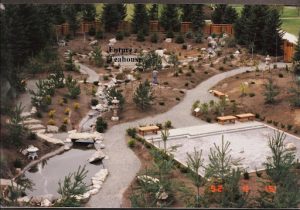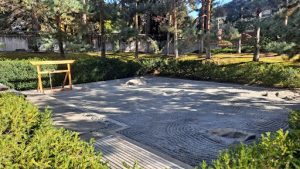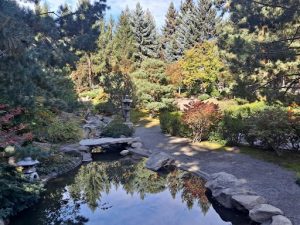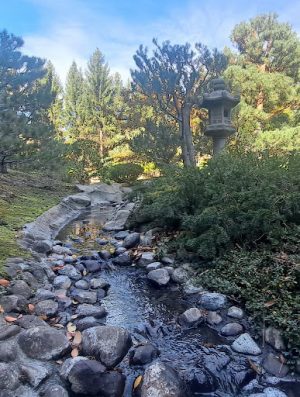Maintaining Mizuno’s Garden
October 7, 2021
Students living on CWU’s campus have likely walked past or through the Japanese Garden, located just west of the SURC. This garden, which was dedicated to late CWU president Donald L. Garrity in 1995 for his commitment to international education, officially opened to the public in April 1992.
The space was designed by renowned Japanese landscape architect Masayuki Mizuno, who 29 years later still visits twice annually to help make sure the garden is still healthy and providing a peaceful space where students and bypassers can experience nature on campus.
“There were a series of years where he wasn’t under contract to maintain it,” said grounds supervisor Blair McNeillie. “In 2015 we invited him back and twice a year he comes back to help us do the pruning.”
According to McNeillie, the times that Mizuno returns to the garden are the most intensive weeks out of the year. During his visits, he guides the grounds crews and gives them plans for improvements and modifications. All major changes made to the garden since its opening were decided by Mizuno.
“It’s very intense and it’s usually during the middle of summer which is very hot and a little uncomfortable,” McNeillie said. “But it’s a rewarding place because it’s the one place on campus where we get to do landscaping as art as opposed to just keeping it safe and clean.”
The rocks and plants found in the garden were specifically chosen by Mizuno, who personally directed their placement on site. The large granite rocks in the garden were trucked to the site from Maranokos in Preston Washington and placed using a truck mounted crane.
The garden is also lined with Austrian pine trees, which aren’t typically seen in Japanese gardens, but were selected due to unique climate and growing conditions.
When the garden was originally built, plans were made for a Teahouse to be constructed on a patch of gravel towards the western end. No teahouse was ever built, but that doesn’t mean it’s out of the question.
Facilities Planning officer Doug Ryder, who served as project manager on the garden back in 1991, said they’re still discussing adding structures, but nature is the real focus of the garden.
“It’s more about nature than it is about physical structures,” Ryder said. “There are some physical structures like benches that are very appropriate in a Japanese Garden, but it’s very much in a controlled and intentional way.”
The site also includes a sand and stone garden, which is made up of decomposed granite, a closed loop water feature and stone lanterns which were hand crafted from solid granite and donated to the garden from CWU’s sister community in Japan, Sanda City.
“The origins of the garden go back to our international studies and programs,” Ryder said. “We’ve got a sister city and sister University relationship with Sanda City and Shimane University, and so we’ve got that relationship, and this is a physical representation of that.”
At the request of Shimane University officials in 2019, a cherry tree was planted in the garden to celebrate the continued partnership between the two universities. International Partnerships Manager Rachel Gordon said the garden is a way to remain connected to CWU’s international partners
“Beyond the beauty and tranquility that the Japanese Garden brings to the CWU campus, it also serves as a reminder of the value of being open to cultures different than our own,” Gordon said. “This fall, we welcome nearly 300 international students from 54 countries to the campus, centers and online programs. Like the garden, each of these students help bring a unique cultural experience to the campus and local communities.”
Although the garden opened nearly 30 years ago, Ryder said the garden is actually quite young.
“There are Japanese gardens that are hundreds of years old,” Ryder said. “I look at it as very much a living organism. It’s a work in progress. It’s not something that you build and do minimal improvements. It’s something that requires a great deal of care over the years.”
Ryder believes that students have been very respectful of the garden and said it provides a place where students can go to be calm and decompress.
“It’s rather peaceful,” said Kyrsten Spry, a junior geology major. “It’s a good way to destress from class to be honest.”
Spry said she spends time in the garden at least once a week.
Junior computer science major Corey Palmer, said it’s a much-needed space, especially with the recent influx of students coming to campus.
“The SURC right now is a hustle and bustle, it’s crazy,” said Palmer. “So, it’s nice to have (the garden) whenever you need it.”
There aren’t currently any plans for the garden’s 30th anniversary, but as long as students and faculty continue to utilize and care for the space, it’s serving its purpose.















Robert Stanger • Oct 11, 2021 at 3:40 pm
Sounds beautiful! Can’t wait to see it in person. (Bob Stanger)
Donald Limberg • Oct 11, 2021 at 2:34 pm
Wonderful article. It reminds me of a recent trip to the Japanese garden in Fort Worth, Texas, that we visited when my son, Jeff, and his wife, Kitty, visited us Good Job.